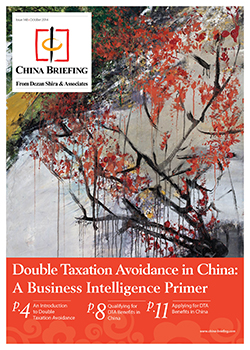Double Taxation Avoidance in China: A Business Intelligence Primer – New Issue of China Briefing Magazine
 The newest issue of China Briefing Magazine, titled “Double Taxation Avoidance in China: A Business Intelligence Primer,” is out now and available as a complimentary download in the Asia Briefing Bookstore through the month of October.
The newest issue of China Briefing Magazine, titled “Double Taxation Avoidance in China: A Business Intelligence Primer,” is out now and available as a complimentary download in the Asia Briefing Bookstore through the month of October.
- An Introduction to Double Taxation Avoidance
- Qualifying for DTA Benefits in China
- Applying for DTA Benefits in China
Rising operational costs in China mean that business owners must be alert to all possible means of maximizing the performance of their China-based investments. As one such measure, the benefits obtainable under double taxation avoidance (DTA) agreements are of critical importance.
Over the past decade, China has taken active measures to promote the use of DTAs, such that it is now signatory to over 100 such treaties, either in-force or pending. This compares with the United States, which has ratified only 68 DTAs (including with China) – many of which are hindered by having been written prior the rise of the Internet.
Yet the complexities of applying for and securing DTA benefits in China – entailing coordination between the requirements of multiple jurisdictions, as well as considerable foresight on the part of foreign investors – mean they are all too often lost in the bureaucratic shuffle.
In our twenty-two years of experience in facilitating foreign investment into Asia, Dezan Shira & Associates has witnessed first-hand the development of China’s double taxation avoidance mechanism and established an extensive library of resources for helping foreign investors obtain DTA benefits. In this issue of China Briefing Magazine, we are proud to present the distillation of this knowledge in the form of a business intelligence primer to DTAs in China.
Asia Briefing Ltd. is a subsidiary of Dezan Shira & Associates. Dezan Shira is a specialist foreign direct investment practice, providing corporate establishment, business advisory, tax advisory and compliance, accounting, payroll, due diligence and financial review services to multinationals investing in China, Hong Kong, India, Vietnam, Singapore and the rest of ASEAN. For further information, please email shanghai@dezshira.com or visit www.dezshira.com.
Stay up to date with the latest business and investment trends in Asia by subscribing to our complimentary update service featuring news, commentary and regulatory insight.
Related Reading
 Revisiting the Shanghai Free Trade Zone: A Year of Reforms
Revisiting the Shanghai Free Trade Zone: A Year of Reforms
In this issue of China Briefing, we revisit the Shanghai FTZ and its preferential environment for foreign investment. In the first three articles, we highlight the many changes that have been introduced in the Zone’s first year of operations, including the 2014 Revised Negative List, as well as new measures relating to alternative dispute resolution, cash pooling, and logistics. Lastly, we include a case study of a foreign company successfully utilizing the Shanghai FTZ to access the Outbound Tourism Industry.
 Adapting Your China WFOE to Service China’s Consumers
Adapting Your China WFOE to Service China’s Consumers
In this issue of China Briefing Magazine, we look at the challenges posed to manufacturers amidst China’s rising labor costs and stricter environmental regulations. Manufacturing WFOEs in China should adapt by expanding their business scope to include distribution and determine suitable supply chain solutions. In this regard, we will take a look at the opportunities in China’s domestic consumer market and forecast the sectors that are set to boom in the coming years.
 Strategies for Repatriating Profits from China
Strategies for Repatriating Profits from China
In this issue of China Briefing, we guide you through the different channels for repatriating profits, including via intercompany expenses (i.e., charging service fees and royalties to the Chinese subsidiary) and loans. We also cover the requirements and procedures for repatriating dividends, as well as how to take advantage of lowered tax rates under double tax avoidance treaties.
- Previous Article Shanghai FTZ Introduces New Batch of Liberalization Measures for FIEs
- Next Article Second Cup? China’s Coffee Industry Revisited









